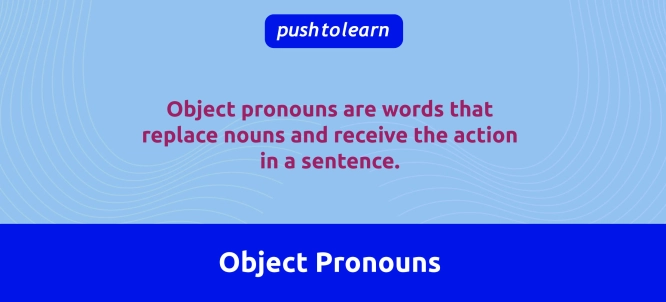by PushtoLearn
Object Pronouns
Table of Contents
Object Pronouns - Exercises
These exercises focus on object pronouns
Table of Object Pronouns
|
Subject Pronoun |
Object Pronoun |
Example Sentence |
|
I |
me |
"He called me yesterday." |
|
You |
you |
"I will help you with this task." |
|
He |
him |
"Can you see him over there?" |
|
She |
her |
"The manager thanked her." |
|
It |
it |
"Please move it closer to the desk." |
|
We |
us |
"They invited us to the meeting." |
|
They |
them |
"I gave them the instructions." |

Tips for Usage
-
Object Pronouns Follow Verbs and Prepositions
-
Object pronouns are placed after the verb or preposition in a sentence.
-
Example: “The teacher helped us” (after the verb “helped”) and “She sat beside him” (after the preposition “beside”).
-
Use Object Pronouns to Avoid Repetition
-
Instead of repeating a name or noun, replace it with an object pronoun to make sentences shorter and clearer.
-
Example: Instead of “I saw Sarah, and I waved at Sarah,” say, “I saw Sarah, and I waved at her.”
-
Agreeing with the Subject Pronoun
-
The object pronoun should match the subject in number (singular/plural) and gender (male/female/neutral).
-
Example: Use “him” for a singular male subject and “them” for plural subjects.
Common Mistakes
-
Mixing Subject Pronouns with Object Pronouns
-
Avoid using subject pronouns (I, you, he, she, we, they) in place of object pronouns.
-
Correct: “She gave me the book.”
-
Incorrect: “She gave I the book.”
-
Forgetting Agreement with the Subject
-
Make sure the object pronoun matches the subject it refers to in number and gender.
-
Correct: “The teacher asked us to study.”
-
Incorrect: “The teacher asked me to study” (if referring to a group).
-
Confusing “Them” and “It”
-
Use “it” for singular, non-human things or animals (unless the animal’s gender is known) and “them” for plural nouns.
-
Correct: “Please put it on the desk” (referring to one item).
-
Incorrect: “Please put them on the desk” (if there is only one item).
FAQ
When should I use “me” instead of “I”?
Use me when it’s the object of the sentence (the one receiving the action), and I when it’s the subject (the one doing the action).
Example: “She called me,” but “I called her.”
Can “you” be used as both a subject and object pronoun?
Yes, you works as both a subject and an object.
Example: “You are kind” (subject), and “I saw you yesterday” (object).
How do I know if I should use “it” or “them”?
Use it for one thing (singular) and them for more than one thing (plural).
Example: “Please move it” (one item), and “Please move them” (several items).
What’s the difference between “him” and “her”?
Him is used for a male subject, and her for a female subject.
Example: “The teacher called him” (male), and “The teacher called her” (female).

